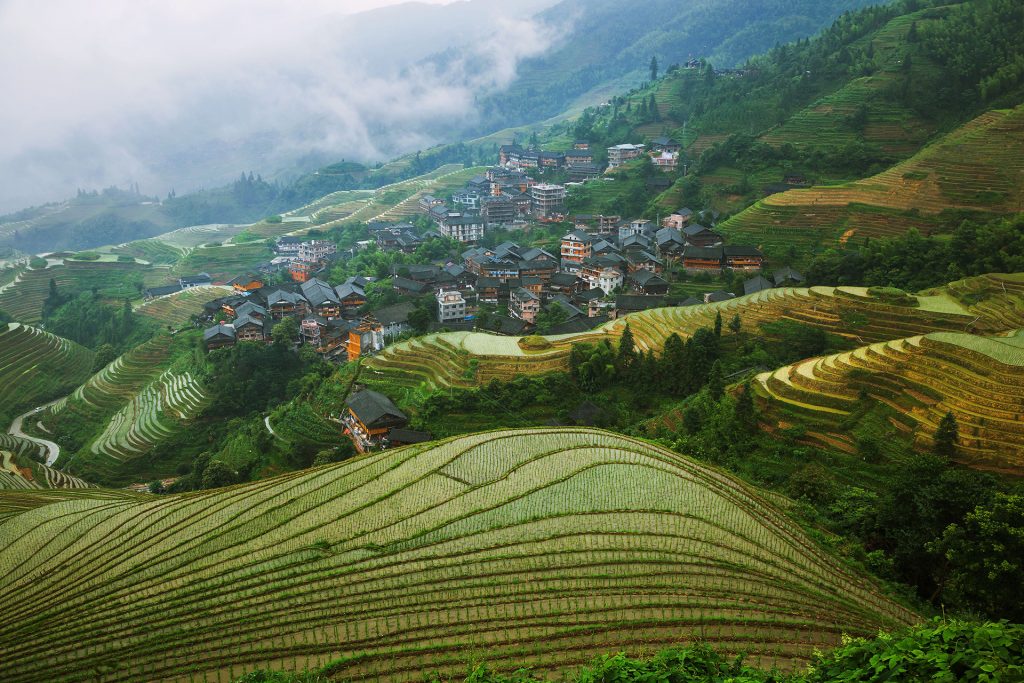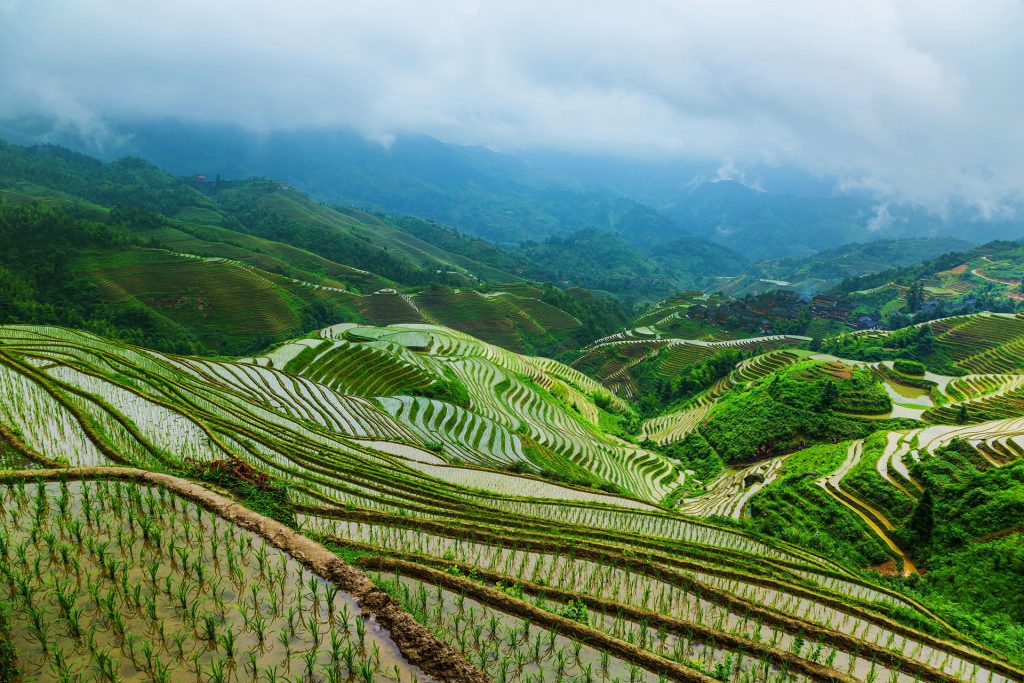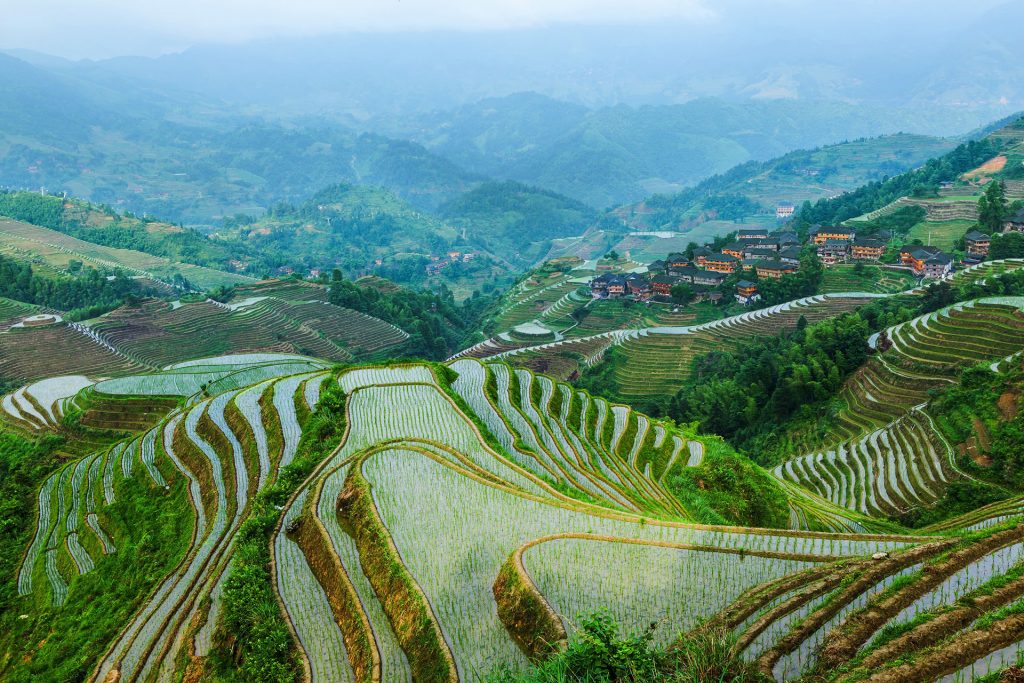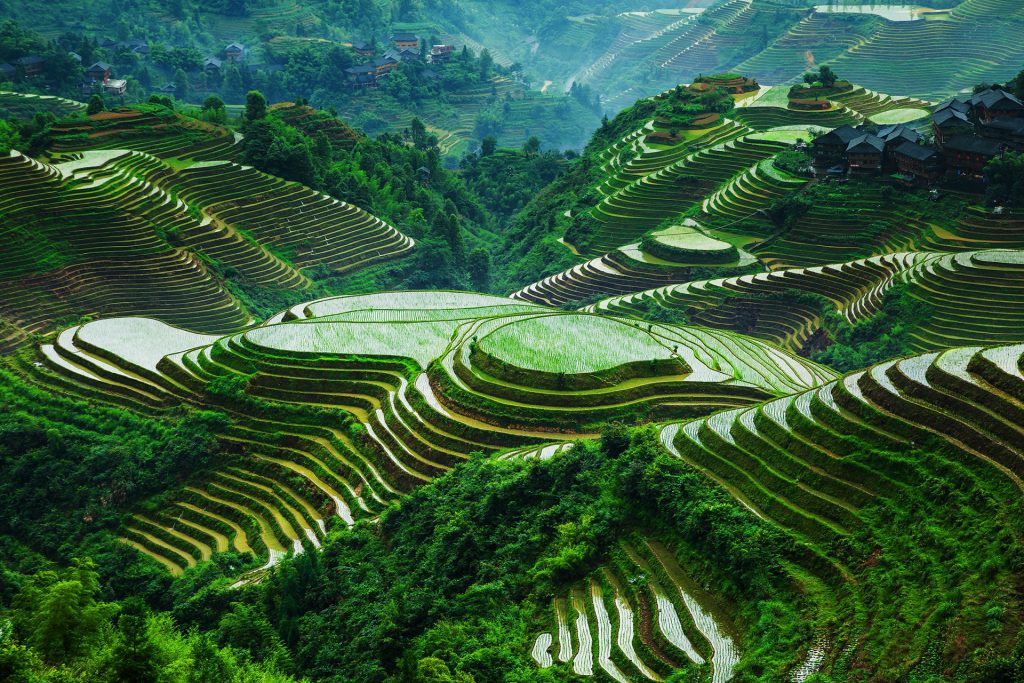The Rice Terraces in Longji village show a picture of great momentum and imposing beauty, being reputed as having no match in the world. Longji Rice Terraces are reached from Guilin by mountain roads amid spectacular scenery. With a history of more than 700 years, the area is still being used for growing premium quality rice by Yao and Zhuang villagers. The rice terraces are built into the hillsides and look like great steps cut into the slopes as they wind around the mountainsides. This ingenious construction makes best use of the scarce arable land and water resources in the mountainous area.
The Rice Terraces are much prettier after the rain, as the morning fog is clearing or while rice is being harvested. If you like to paint or photograph dramatic, beautiful landscapes, this would be a superb destination in which to practice your art; or come here anyway just to look, gaze in awe, and take it all in; it’s a Guilin must-see!
History of Longsheng Longji Rice Terraces
Longsheng Longji Rice Terraces was original built in Yuan Dynasty and completed in the early Qing Dynasty with a history of over 650 years. The ancestors who first cultivate the rice terrace would never think about that their wisdom and hard work could build such a beautiful and amazing scenic area. For such a long time, the strong will for living, the wisdom and power of human is fully presenting on this land.
The terraces like ribbons and chains full of the mountains. The mountains looks just like giant snails or a huge fan. Some like mirror with different shapes. On this wide land, footpath wriggles between terraces. Folk songs linger in between mountains.
It is hard to imagine that 800 years ago howthe first batch of Zhuang and Yao people faced to the deep mountains and forests, and how they rely on original slash-and-burn agriculture and cultivate the first field.
The rice was so attractive for them, maybe they did not think to much, their descendants had already took the hoes from them and cultivate the rice terraces day by day, year by year. From Yuan Dynasty to Qing Dynasty, for about 650 years, the amazing landscape of rice terraces were finally completed.
It is said that a strict master told a famer that he must cultivate 206 pieces of field, if not he could not have a rest. The farmer worked for a whole day and found there was just 206 pieces of field. He did not know what to do. He took the straw rain cape and planed to go back home. He was so surprised that the last piece of field was just under his cape.
What to See
【Jinkeng Rice Terrace】
Jinkeng Rice Terraces is reputed as a unique landscape of the world tourism landscape. The rice terraces here are so grand with cloud and mist surrounding the summit of the hills. And you will also find Yao Village with unique characteristics. Here is not just the heaven for photographers from domestic and overseas, but also a wonder place for leisure sightseeing of tourists all over the world. The whole scenic area covers over 10 square km. The terraces were cultivated since Yuan Dynasty with a history of hundreds of years.
In the mountains of the northeast part of Heping Village in Longshen County lies the Dahzai Village. It is over 10 square km in area with over 20 cottages and a population of more than 5000. Hong Yao, a breach of Yao ethnic group, is living here. The ancestors of Hong Yao people were moved from Donting and Wuxi of Hunan Province, and they brought an advanced technique of growing rice. Now, the field in front of Dazhaicun School was the earliest field cultivated by their ancestors.
Hong Yao people do not have their own characters, and the history of them was passed down by folk songs. They are very simple and hospitality. The women here love red color clothes, hence the name of Hong Yao.
【Pingan Rice Terrace】
Pingan Rice Terraces across Pingan and Longji administrative villages like a moving dragon on this land with wild power which can shake the heaven and earth.
Pingan Rice Terraces’s highest altitude is 880 m, and the lowest is 380 m, with vertical elevation difference of 500 m, covering an area of over 4 square km. The terraces like ribbons or chains wreathe from the foot to the top of the mountain. The small hills look like snails, and the large hills look like pagodas. In spring, there are layers of silver ribbons; in summer, green waves will be full of your views; in autumn, golden pagodas stands one by one; in winter, groups of dragons play with water. In the world of terraces, there are 15862 pieces of fields. The largest one is just 0.62 mu, while the smallest one just have space for 3 plants.
【Ethnic Villages in Longji Rice Terraces Scenic Area】
Ethnic Villages in Longji Rice Terraces Scenic Area such as Pingan Zhuang Village, Jinzhu Zhuang Village, Huangluo Yao Village, Longji Ancient Zhuang Village and other villages are very worth for a visit.
【Longji Old Village Cultural Terraced Field】
Longsheng Longji Rice Terraces Scenic Area covers an area of 70.1 square kilometers. Longji Old Village Cultural Terraced Fields is a part of the scenic area located in Longji Village. The terrace field in Longji Old Village has a high ornamental value of humanistic and terraced fields ornamental value. There are 300 families live in this village with a population of over 1300 . The surname of the people here are Liao, Hou and Pan, they are all North Zhuang people.
Longji Four Treasures
Longji Four Treasures are tea, chili, watery wine and sticky rice which are specialties of Longji Rice Terraces Scenic Area.
【Longji Cloud and Mist Tea】
Longji Cloud and Mist Tea grow in the Longsheng Longji Rice Terraces Scenic Area. The altitude of the tea garden is above 800m, and it belongs to subtropical monsoon region. Affected by warm and cool air, there has four distinctive seasons and abundant precipitation. The sunshine time is short and there is mist and cloud surrounded which is a very ideal place for growing tea. The Cloud and Mist Tea has a long history. It was the tribute in Qianlong Period during the Qing Dynasty. And it was recorded as one of the 28 best teas in China in Ci Dian. It tastes a little bitter at first and then becomes fresh, sweet and strong.
【Longji Sticky Rice】
Longji Sticky Rice is the main material for making watery wine.
【Longji Watery Wine】
The water wine, made of Longji sticky rice, is very fresh and sweet. It has the reputation as “Longsheng Maotai”. Longsheng watery wine is a kind of unadulterated folk wine. It is not so famous but it has good reputation in Longsheng County and praised by each ethnic people here. The watery wine is the original liquid of sticky rice with sweet spring water. It tastes sweet with rich nutrition. It is said that the people in the 13 villages in Longji all drink watery wine and they have ruddy skin and can live longevity and healthily. The wine is sweet but it has delayed effect on people. If you are drunk, you may sleep on bed for several days.
【Longji Chili】
Longji Chili has a special smell. Its pericarp is not thick and not too hot. Longji Chili grows on the hill 800 m above sea level. The chili is in the shape of ox horns with bright color. The pulp is thick. Eating Chili could offer people the vitamins they need, stimulate one’s appetite and refresh one.
Best Time to Visit Longsheng Longji Terraces
Best Time to Visit: after lunar April 15
1. From May 25 to June 11, when the rice were just transplanted, the terraces are filled with water, the scenery is very beautiful
2. Middle July: the rice just grows up and fields are so green and the weather here is very cool.
3. Before or after Mid-Autumn Day: the whole area is golden.
4: Snowy days in winter from middle Dec. to the next Feb.: there will snow for one or twice in a year. The terraces have special scenery when covered with snow.
Best place to appreciate the beautiful scenery
Seven Star Accompanying the Moon (Qi Xing Ban Yue): the photos taking from this spot are very beautiful, and you can rent ethnic costumes and accessories and take picture wearing them.
Dasai No.1 Scenic Spot: the spot is relatively higher then around spots with altitude of 955m. It is a good place for watching the sunrise and sunset. It is a little far and may take you about 45 m from the village. It is good to take picture of terraces in backlighting in afternoon here.
Dasai No.2 Scenic Area: a little far, good for watching sunrise.
Dasai No. 3 Scenic Area (Da Mao Gai): the furthest, highest, and most grand spot for watching the sceneries.
Longji Rice Terraces Photography Tips
According to experts, Longsheng Longji Rice Terraces is suitable for taking photograph all the year round. At different timing, there will be a different theme.
Best time to take photograph in Longji Rice Terraces:
【From May 25 to June 10】
During this half month, the rice terraces are filled with water, the weeds growing at the muddy rows are shoveled cleanly. The field looks smooth and shining like a mirror. You can often see famers working in the field. Backlit shooting is the best angle to avoid the sun’s specular light metering zone, otherwise it will be underexposed.
【In mid-July】
In mid-July each year is the 2nd good time to shoot the rice terraces. At this time, the rice turning green and just in the growing season. The terraces are green. In backlight irradiation it is showing rich layers of green lines, full of vitality, which is a good time to take good pictures. Choose a sunny day, at 8:00 and 17:00, is the best cinematography time period.
【Around 5 days before or after Mid-Autumn Day】
Each year around 5 days before or after Mid-Autumn Day is the third good period for shooting. The terraces are in golden color, bright and shinning. The wooden farmhouse hangs full of red pepper. The whole land is a harvest scene. In the morning and evening of fall, it is more often to see the rosy clouds of dawn. Sometimes you can encounter Jesus mysterious light. The terraces under the morning mist and in the refraction of the sun have rich tone layers and strong perspective sense.
【In Winter】
In winter, snow-covered landscape is also very worthy for shooting. Covered by snow, the terraced lines are even more eye-catching. The snowy ridges of mountains like a dancing silver snake. However, it is hard to meet the snowy days in Longsheng Longji Rice Terraces. Furthermore, in addition of the terraced landscape, the customs and folklore are good creative photographic subjects, do not miss them.




